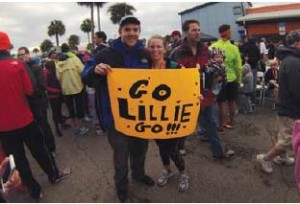After Heart Surgery Simmons Is ‘Bionic’
As she was getting ready for work a year-and-a-half ago, Lillie Simmons felt lightheaded, as if she was about to pass out. It wasn’t the first time it had happened to her. Growing up she had experienced similar episodes, usually provoked by certain triggers. But on this particular morning no triggers were present and Simmons decided to call her general practitioner for a check-up.
These episodes are now thought to be emphasized by her heart condition. The results of an echocardiogram revealed that Simmons had an undiagnosed atrial septal defect. A hole in her heart the size of a nickel was allowing the oxygenated and unoxygenated blood to mix, and the left side of her heart was becoming enlarged by laboring overtime to compensate for the defect.
Simmons was stunned.
“You hear, ‘you have a hole in your heart,’” she recalled. “It’s kind of a shock. Am I Okay?”
A Naples native, the 24-year-old Simmons had always been active. In high school, she had been a  swimmer and lacrosse player. She also enjoyed running. But she often felt tired, and sometimes struggled to push herself through the day.
swimmer and lacrosse player. She also enjoyed running. But she often felt tired, and sometimes struggled to push herself through the day.
Her doctors explained that the hole had existed since birth, and in most cases, would have closed around that time. They were quick to reassure Simmons that the defect could be corrected with surgery, and also noted that it could lead to other problems later in life if not fixed.
“If you think about it, your heart’s usually the size of your fist,” said Simmons, who works for Arthrex. “If you make a quarter on that, that’s pretty big.”
The American Heart Association estimates that 43 million women in the United States are affected by cardiovascular disease, making it their No. 1 health threat and affecting more women than all forms of cancer combined. While one in 30 women die from breast cancer each year, one in three women die from cardiovascular disease.
Simmons chose an Orlando pediatric cardiologist to perform the surgery that would close the hole in her heart by placing a small, umbrella-like device over the hole. Once the device was in place, tissue would grow over the device within six months.
Almost immediately after the surgery, Simmons noticed a change.
“I have so much more stamina. I have more sustained energy,” she said. “I didn’t realize how fatigued I was getting before.”
Just 10 days after the surgery, she decided to run a 5K race in Naples. Four months after the surgery, she competed in her first half marathon. Deciding to participate in these events was as much of a mental comeback as it was a physical one, Simmons explained.
“I didn’t want that defect to hold me back mentally,” Simmons said. “I didn’t want it to be a crutch for me. I needed to get out there and do it.”
Sometimes, Simmons even likes to joke that she has a special advantage over her competitors.
“I’m bionic now,” she said with a laugh. “I can do that.”

Leave a Reply
Want to join the discussion?Feel free to contribute!